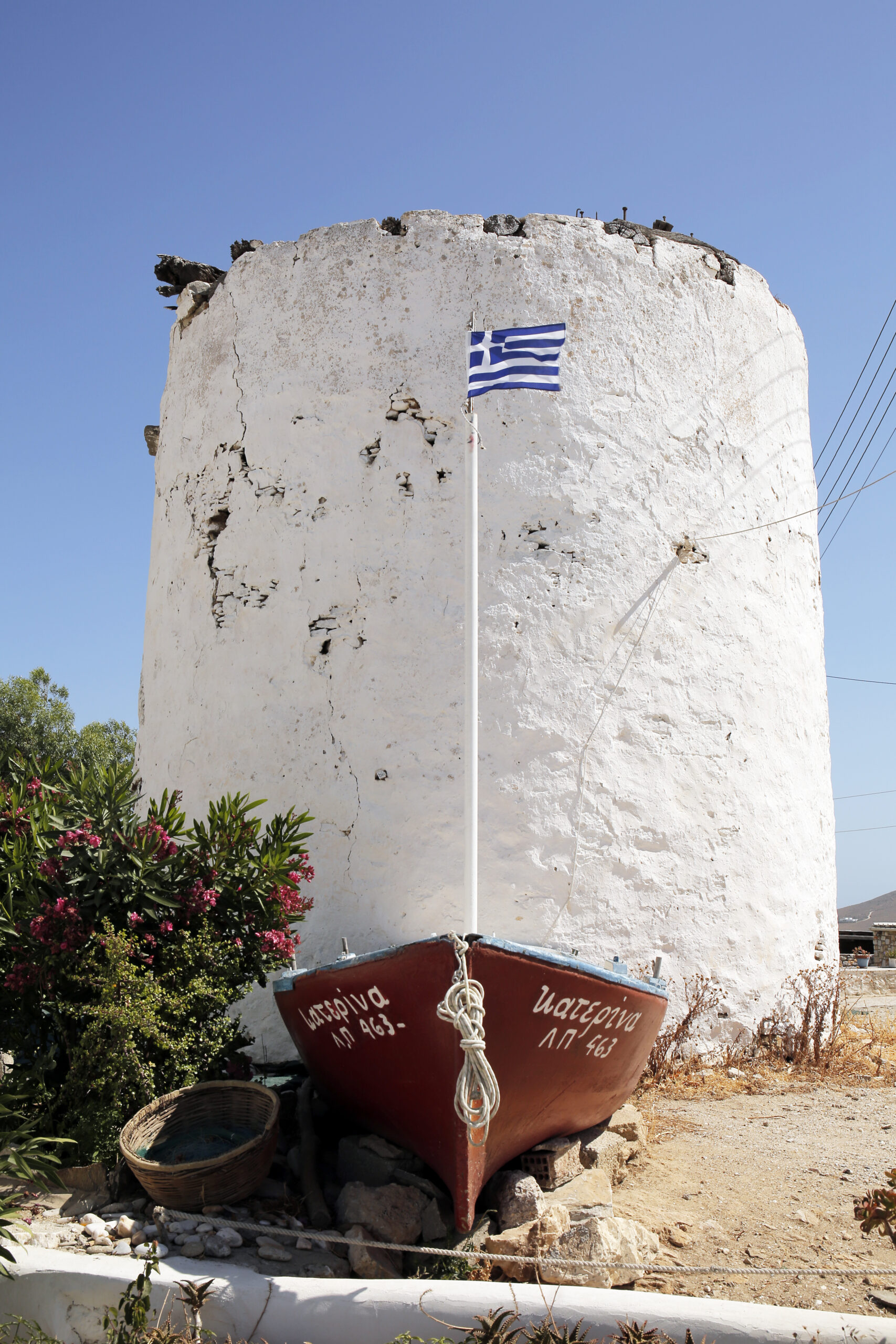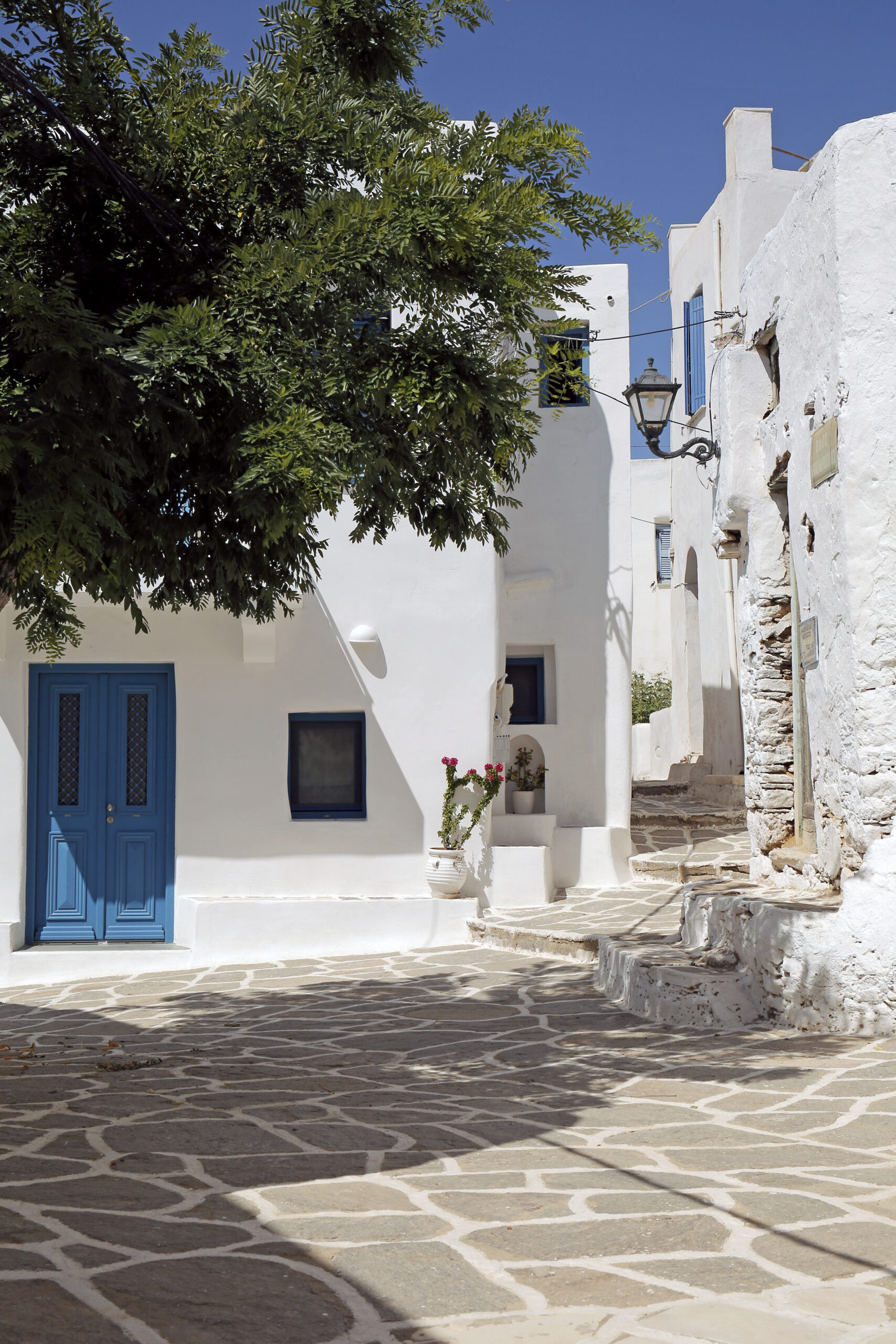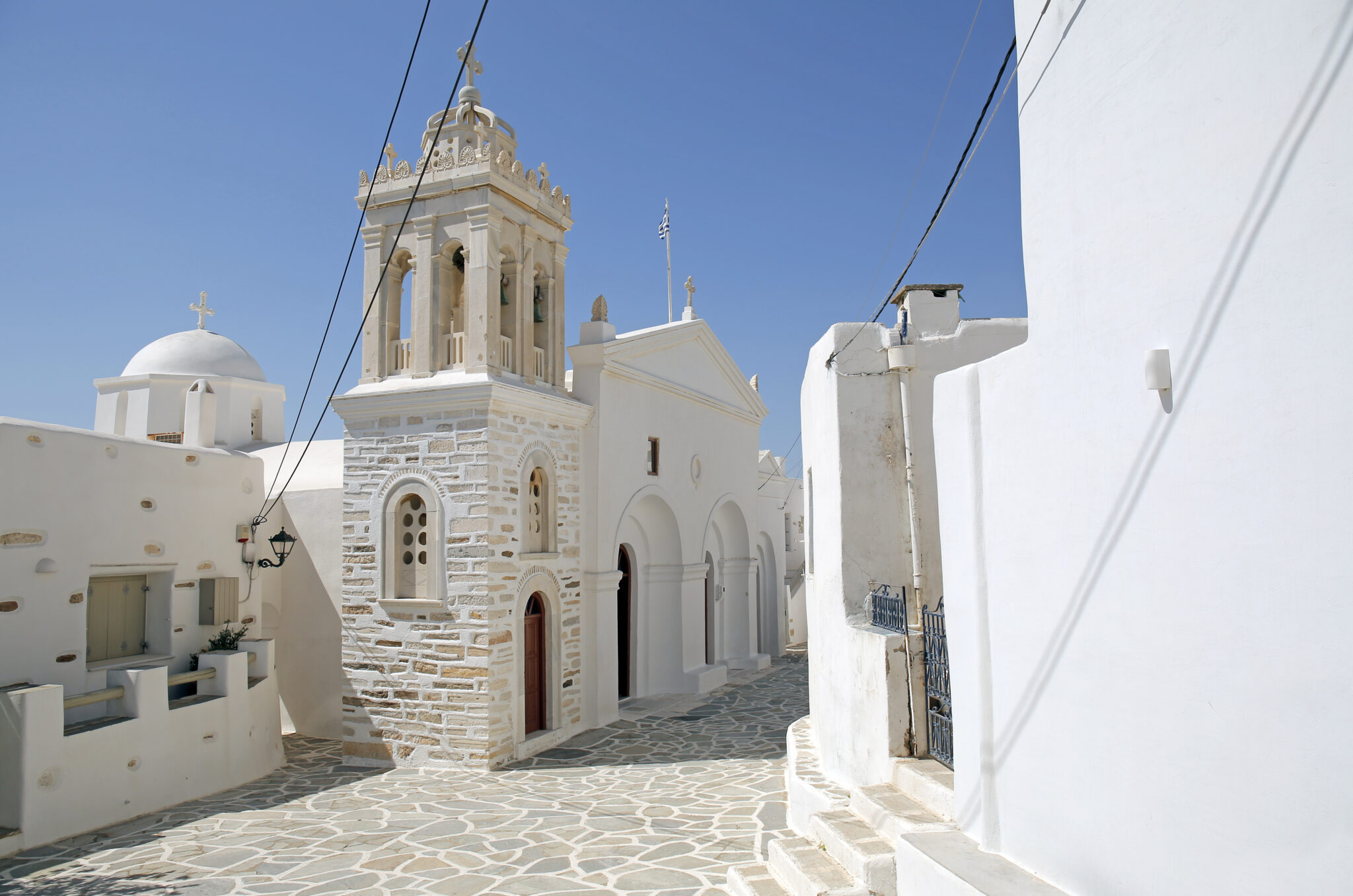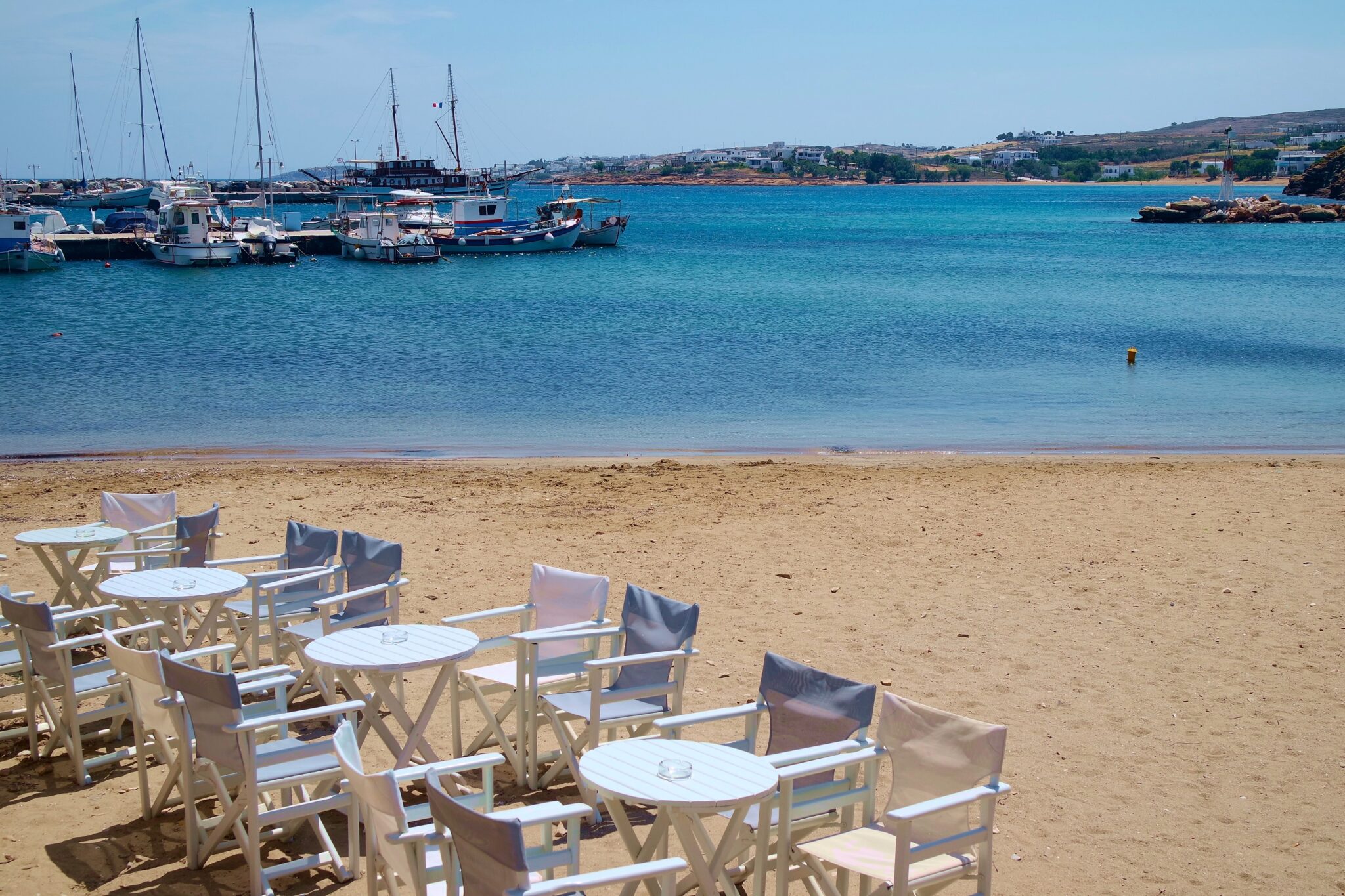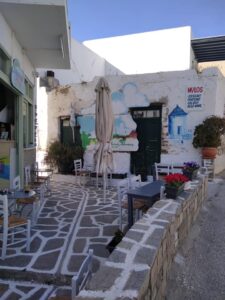Witness the transformation of a picturesque village nestled in the mountains of Paros into a flourishing tourist destination
Tucked away within Paros’ scenic mountainous landscapes, at the end of a winding road that stretches from the captivating heights of Leukes to the coastal town of Piso Livadi, lies a modest village that perfectly embodies the essence of this beloved Greek island in its narrow streets.
Marpissa, formerly known as Tsipidos until 1926, serves as a bridge between Paros’ raw, traditional character and its cosmopolitan, tourist-filled façade—a necessary stopover between the serene mountains and the crystal-clear sea.
With only 582 permanent residents, Marpissa boasts an impressive history dating back to the late Neolithic period. Archeological findings from the renowned Cave of Demons on Mount Prophet Elias, near the village, suggest its ancient roots. The site has also yielded artifacts from the early and late Cycladic periods, as well as the Mycenaean era. A ruined castle atop Kefalos hill stands as a testament to the Venetians’ presence in the village during the 13th century.
Marpissa’s castle, the third built by the Venetians on the island after those in Parikia and Naousa, is believed to have been besieged and conquered by the pirate Barbarossa in 1537. Today, the Monastery of Agios Antonios stands in its place, majestically overlooking the village and the neighboring hamlets. At night, the illuminated monastery creates a breathtaking panorama when viewed from Marpissa, Prodromos, or Marmara.
For avid Paros enthusiasts who frequently visit the island, Marpissa has become an increasingly popular tourist destination. Located next to Prodromos, another traditional village that attracts a significant crowd every year for its celebrated Chickpea Festival, Marpissa welcomes more visitors during the holiday season. Its narrow streets now bustle with travelers who choose to spend their summer vacations in the village, infusing the area with life from June to September.
The village’s four windmills are iconic symbols, with the first one marking the village entrance. The Church of Christ also holds great significance in the island’s culture, particularly during Easter and the Assumption celebration in August.
Exploring the Perantinos Sculpture Museum
Sitting proudly within Marpissa’s charming settlement is one of the Cyclades’ most captivating museums, the Nikos Perantinos Sculpture Museum.
Founded in 1991 shortly after the renowned Parian sculptor’s death, the museum offers a glimpse into the fascinating world of Nikos Perantinos. Originally housed in a small hall, it has expanded over the years with the support of the Municipality of Paros and the Ministry of Culture. Today, it occupies a beautifully renovated neoclassical building, featuring five spacious halls.
Nikos Perantinos, the son of Leonardos Perantinos from Marpissa, Paros, and Angeliki Metaxa from Syros, graduated from the School of Fine Arts and continued his studies in Paris. As the permanent sculptor of the Archaeological Museum, he conducted significant restorations of ancient sculptures. Perantinos received numerous awards and distinctions throughout his career, known for his mastery of simplicity and classical form. In 1964, after returning from Paris, he established the Marble Sculpture Workshop in Agia Anna, Paros, with the goal of preserving the island’s sculptural tradition. These workshops welcome individuals of all ages who share a passion for the art of sculpture.
Take a leisurely stroll through the enchanting village of Piso Livadi and immerse yourself in its beauty. Departing from Marpissa’s picturesque settlement, follow a delightful asphalt road that meanders through majestic trees until you reach the sea. For regular Paros visitors, this road holds the promise of glimpsing the alluring sight of Piso Livadi. As you approach, the village reveals itself with its dazzling white buildings, boats serenely anchored in the azure bay, and a captivating row of restaurants and cafés lining the shore.
Upon arriving in the small settlement, turn right and continue along the winding road with the sea on your left. Soon, you’ll encounter the village’s modest public parking lot, where most visitors leave their vehicles. However, due to the island’s rapid development, finding a parking spot here can be quite challenging at any time of the day.
Picture a tranquil morning spent on the eastern side of Piso Livadi, where you’ll discover a peaceful and shallow bay. Families with young children frolic on the soft sand, while others relish a refreshing swim in the crystal-clear waters. Despite the presence of impressive inflatables and sizable yachts that ferry travelers from across the Cyclades, Piso Livadi’s marina has managed to maintain its allure. Here, the long-standing tradition of sculpture harmoniously coexists with the irresistible charm of the Greek islands, creating a captivating blend of history and beauty waiting to be explored.
As the day progresses and the sun begins to set behind the jetty that stretches along the seafront, Piso Livadi comes alive with a vibrant and stylish crowd. This peaceful village on the island’s eastern side unveils its true nature, showcasing its popularity and radiance. Finding a parking spot can be a challenge during this time, so it’s best not to take any chances if you spot an available spot on the road before reaching the village. While Parikia serves as the lively capital and Naousa shines as Paros’ glamorous gem, Piso Livadi remains an unassailable haven of tranquility, favored by those seeking a relaxed night out on one of Greece’s most beloved islands.
For delicious and refreshing cocktails, secure a table at Brazil. With its striped white-and-yellow cushions and a canopy providing ample shade, this establishment exudes a welcoming atmosphere. If you prefer to enjoy your drink right on the sand, Remezzo and Vroha are classic choices. Families and groups often gather here from early morning for a swim, extending their stay into the afternoon to indulge in delectable crepes, pizza, or wine. If you’re in search of a rooftop experience with panoramic views, look no further than Ostrako. They serve homemade ice cream, fresh waffles, and provide the best vantage point to admire the village.
Craving a dip in the enchanting waters of Logaras? This serene beach, along with Molos and Kalogeros, awaits just beyond Piso Livadi. Logaras has undergone significant changes, transitioning from a quiet destination beloved by families to a burgeoning hotspot on the island. However, amidst the modern developments, Logaras has managed to retain its tranquil and warm ambiance that characterized the beach for decades. Large groups of cheerful families still occupy the front tables of the legendary Fysilanis tavern, equipped with oversized beach bags, arm floats, and life vests, ready to spend the entire day there. Platters of hearty breakfast dishes come and go, followed by mezze or freshly prepared delicacies. As the afternoon unfolds, the action shifts to the modern Cactus, where tables are set by the water’s edge, allowing guests to savor refreshing cocktails and well-grilled meat dishes. At the beginning of the beach, the newly arrived white oasis known as Magoo transports you to the elegance of Italy’s Positano, offering beach chairs atop the rocks.
Between Marpissa and Piso Livadi lies a road that leads to two more stunning beaches on the island’s eastern side. Molos and Kalogeros beaches are unorganized, maintaining the untouched natural beauty of the island. If you’re a fan of water sports, head to Molos, where you can rent the necessary equipment. The beach boasts soft, golden sands and is particularly popular among families. Just before reaching Molos, a small path will lead you to Kalogeros, a truly serene and secluded beach. The beach’s name originates from an old legend of a monk who leaped from the rocks and drowned in its waters. Kalogeros holds a special place in the hearts of Paros’ visitors, thanks to its sand infused with therapeutic clay said to possess healing properties.
Dining
George and Anna
When it comes to dining, George and Anna’s place is considered one of the island’s top taverns, and rightfully so. Situated in the Marbles district of Paros, right next to Marpissa, this restaurant commands a scenic view of the surrounding areas from its hilltop location. If you have an affinity for meat dishes, a meal at George and Anna’s is an absolute must. Indulge in their splendid array of dishes, ranging from exceptional pork belly and beefsteaks to traditional souvlaki and Paros-style sausages. Don’t forget to leave room for their generous appetizers, fresh salads, and local cheeses. They also offer a modest yet elegant selection of seafood. Truly a stellar dining option on the eastern side of Paros. If you plan on visiting for dinner, it’s advisable to reserve a table, as the restaurant tends to be quite busy, especially during the peak months of July and August.
Ta Magkalakia
The term “hidden gem” is often used to describe secret spots known only to a select few, and Ta Magkalakia in Paros’ Marbles district, adjacent to Marpissa, perfectly embodies this notion. This grill house opens only in the late afternoon, and as night falls, its limited tables quickly fill up with patrons eager to savor their fantastic kebabs, freshly fried potatoes, perfectly cooked pitas, and amazing gyros. Settle down at one of the tables in the small square of the village and enjoy a peaceful and low-profile Parian experience, far removed from the glitz of Naousa or Parikia.
Milos
On your way to the Marpissa settlement, you’ll encounter Milos, a quaint and traditional souvlaki joint situated in a windmill that occupies a central position in the village. This charming establishment features a small cobblestone courtyard with a handful of tables, often filled with patrons indulging in generous and budget-friendly portions of meat-heavy dishes. Milos has earned a stellar reputation, with many visitors specifically coming to Marpissa for a taste of their renowned souvlaki. You might have to wait for a table, be it during lunchtime or in the evening, but trust me, it’s well worth it.
Source: travel.gr



